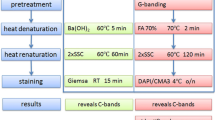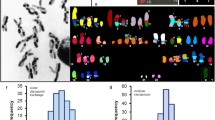Abstract
The G-band patterns of mitotic metaphase chromosomes No. 1 and 2 of the Chinese hamster cells correlate closely to the chromomere patterns of the meiotic pachytene bivalents. This is interpreted to indicate that the regions of centromeric and intercalary heterochromatin, which are more tightly condensed or more tightly packaged during interphase, tend to remain so during meiosis and mitosis.
Similar content being viewed by others
References
Barr, G. F., Mikel, U., Engler, W. F.: Correlates of chromosomal banding at the level of ultrastructure. In: Chromosome identification—Techniques and applications in biology and medicine (T. Caspersson and L. Zech, eds.). Nobel Symp. 23, p. 280–289. New York: Academic Press 1973
Berlowitz, L.: Analysis of histone in situ in developmentally inactivated chromatin. Proc. nat. Acad. Sci. (Wash.) 54, 476–480 (1965)
Burkholder, G. D.: Electron microscopic visualization of chromosomes banded with trypsin. Nature (Lond.) 247, 292–294 (1974)
Comings, D. E.: Heterochromatin of the Indian muntjac: Replication, condensation, DNA ultracentrifugation, fluorescent and heterochromatin staining. Exp. Cell Res. 67, 441–460 (1971)
Comings, D. E.: The structure and function of chromatin. In: Advanc. Hum. Genet. 3, 237–431 (1972)
Comings, D. E.: Biochemical mechanisms of chromosome banding and color banding with acridine-orange. In: Chromosome identification—Techniques and applications in biology and medicine (T. Caspersson and L. Zech, eds.), Nobel Symp. 23, p. 293–299. New York: Academic Press 1973
Comings, D. E.: The structure of human chromosomes In: The nucleus (H. Busch, ed.). p. 537–562. New York: Academic Press 1974)
Comings, D. E., Avelino, E.: Mechanisms of chromosome banding. II. Evidence that histones are not involved. Exp. Cell Res. 86, 202–206 (1974)
Comings, D.E., Avelino, E., Okada, T. A., Wyandt, H. E.: The mechanism of C- and G-banding of chromosomes. Exp. Cell Res. 77, 469–493 (1973)
Ferguson-Smith, M. A., Page, B. M.: Pachytene analysis in human reciprocal (10∶11) translocation. J. med. Genet. 10, 282–286 (1973)
Gallimore, P. H., Richardson, C. R.: An improved banding technique exemplified in the karyotype analysis of two strains of rat. Chromosoma (Berl.) 41, 259–263 (1973)
Golomb, H. M., Bahr, G. F.: Correlation of the fluorescent banding pattern and ultrastructure of a human chromosome. Exp. Cell Res. 84, 121–126 (1974)
Heneen, W. K., Caspersson, T.: Identification of the chromosomes of rye by distribution patterns of DNA. Hereditas (Lund) 74, 259–272 (1973)
Kakati, S., Sinha, A. K.: Banding patterns of Chinese hamster chromosomes. Genetics 72, 357–362 (1972)
Kato, H., Yosida, T. H.: Banding patterns of Chinese hamster chromosomes revealed by new techniques. Chromosoma (Berl.) 36, 272–280 (1972)
Lima-de-Faria, A.: Differential uptake of tritiated thymidine into hetero- and euchromatin in Melanoplus and Secale. J. biophys. biochem. Cytol. 6, 457–466 (1959)
Lima-de-Faria, A., Gustafsson, T., Jaworska, H.: Amplification of ribosomal DNA in Acheta. II. The number of nucleotide pairs of the chromosomes and chromomeres involved in amplification. Hereditas (Lund) 73, 119–142 (1973)
McKay, R. D. G.: The mechanism of G and C banding in mammalian metaphase chromosomes. Chromosoma (Berl.) 44, 1–14 (1973)
Rodman, T. C.: Human chromosome banding by Feulgen stain aids in localizing classes of chromatin. Science 184, 171–173 (1974)
Rodman, T. C., Tahiliani, S.: The Feulgen banded karyotype of the mouse: analysis of the mechanisms of banding. Chromosoma (Berl.) 42, 37–56 (1973)
Vogel, W., Faust, J., Schmid, M., Siebers, J. W.: On the relevance of nonhistone proteins to the production of Giemsa banding patterns on chromosomes. Humangenetik 21, 227–236 (1974)
Yunis, J. J., Sanchez, O.: G-banding and chromosome structure. Chromosoma (Berl.) 44, 15–23 (1973)
Author information
Authors and Affiliations
Rights and permissions
About this article
Cite this article
Okada, T.A., Comings, D.E. Mechanisms of chromosome banding. Chromosoma 48, 65–71 (1974). https://doi.org/10.1007/BF00284867
Received:
Issue Date:
DOI: https://doi.org/10.1007/BF00284867




